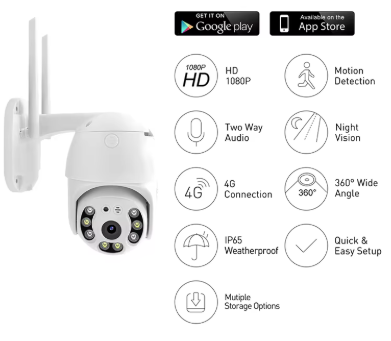Megértés 4G kamera TECHNOLOGIA
Hogyan működnek a 4G kamerák WiFi nélkül
Mi rejtőzik a névben: 4G-s kamerek A 4G kamerek játékváltoztatóak, mivel telefonhálózatokat használnak a videók átviteléhez, anélkül, hogy wifi szükséges lenne. Videót fájlok sorozatánaként rögzítenek és streamelnek webvideót, valamint a 4G hálózatot használják a videofeedek továbbítására távoli szerverre vagy alkalmazásra, amely lehetővé teszi az élő figyelmet majdnem bárki helyről. Ez különösen hasznos olyan vidéki területeken, ahol csak minimális vagy egyáltalán nincs internetinfrastruktúra, így a klasszikus rendszerek nem működnekene. Közeli mobiltelefonok Visszatérve a témához, valószínűbb, hogy biztonságosabb a mobilhálózat adatok használata, mivel kevesebb eséllyel vannak védelem nélkül. Ez segít abban, hogy a 4G kamerek energiamegtakarékos opciók legyenek a rács mentes biztonsági igényekhez, és így még egy réteget adnak a rugalmasságukhoz akár a legnehezebb helyzetekben is.
Fő előnyei a konverziós rendszerekkel szemben
A 4G kamerák konceptusa, hogy nem kell kapcsolni őket rögzített vezetékes hálózatokhoz, ami nagyobb rugalmasságot biztosít. Nem igényelnek annyi vezetéket, mint a tradiós rendszerek, kevesebb előzetes költség jár velük, és kevesebb zavart okozanak. Ezek a kameralapok természetesen logikus választás, ha már felhőalapú tárhelyszolgáltatást használsz, és olyan kamerát keresel, amely egyszerűen csatlakozhat hozzá. Mind ezek a rendszerek népszerűek, és a felhasználói elégedettség kb. 70%-os arányban van a rendszerek könnyen használhatóságán és megbízhatóságán alapulva minden felmérésben. A 4G Kamera rugalmas, költséghatékony, könnyen használható, biztonságos és védelmi rendszeret ad bárhol, ahol mobiljel lefedettség van.
Tipikus alkalmazások és hasznációs esetek
Végső gondolatok: A 4G kamerák egyre hasznosabbak váltanak számos környezetben, különösen olyan helyeken, amelyek távoli vagy biztonsági igényekkel járnak. Növénytermesztés terén is rendkívül értékesek, ahol a gazdálkodók folyamatosan figyelhetik a térmésüket, védelmezve őket láthatatlan fenyegetésektől. Az építési területeken az ideiglenes biztonság valósággá válva ezek a kamerák megoldást kínálnak a bűnözés és a sabotozás megelőzésére. Emellett a 4G kamerákat a biztonsági szektor is használhat ideiglenes, dinamikus figyelőrendszerként események során, így javítva a mobil egységek által biztosított nyilvános biztonságot. A 4G kameráknak köszönhetően a biztonsági gyakorlatok fejlesztésének pozitív bizonyítéka több felhasználási esetre utal, amelyek bizonyították, hogy ezek a berendezések értékesek számos iparágban.
A minőségi 4G kamerák alapvető jellemzői
Energiakezelés és akkumulátor élettartam
A magas minőségű 4G kamerák egyik nagy erőssége a teljesítménykezelésük és a hosszú akkumulátor élettartamuk. A okos energiakezelési rendszerek köszönhetően sok ez a kamerák napokig működnek vége nélkül töltés nélkül. Okos teljesítménykezelési funkcióval rendelkeznek, amely minimalizálja az energiakulcsot, miközben hosszabb futásidejű megoldásokat tesznek lehetővé. Valós idejű figyelési funkciók is hozzá lettek adva, amelyekkel ellenőrizni lehet az akkumulátor kapacitást, és tervezni a töltés időpontját. Más modelljeivel való összehasonlításnál, a kiváló akkumulátor technológia meghosszabbítja a zeneszórók működési idejét különböző környezetben egyszerűen.
Haladó mozgásérzékelési képességek
A 21. századbeli 4G kamerák egy világot kínálnak sofisztikált mozgásérzékelési technológiákkal, amelyek mesterséges intelligenciát (AI) használnak a hamis riasztások és a valódi fenyegetések megkülönböztetésére. Ez az AI-integráció sokkal pontosabb figyelést és riasztást tesz lehetővé. A érzékenységi szinteket a felhasználók testreszabhatják a mozgásról küldött értesítésekhez, attól függően, milyen tevékenységről szeretnének értesítést kapni. Ezek az értesítések valós időben kerülnek közvetlenül a felhasználói eszközökön, és lehetővé teszik a szükség esetén azonnali interakciókat. A kutatások azt mutatták, hogy a fejlett mozgásérzékelési képességek jelentősen csökkentik a nem észlelt riasztások számát, ami növeli az élmény értékét és a biztonság képességeit.
Éjszakai látás és képbontás
A prémium 4G kamerák rendelkeznek kitűnő éjszakai látótávolsággal, ezek a 4G kamerák infravörös (IR) technológiát használnak, amely biztosítja a tisztaságot akár az éjszaka legfeketebb óráiban is. Továbbá, ezek a kamerek általában HD videofelbontású lehetőségekkel rendelkeznek, így nem vesztesz videó-tisztaságot, még akkor sem, ha messze figyelsz. Néhány prémium modell akár éjszakai látást és magas felbontást is kombinál, amely napnyi, éjnyi figyelmet tesz lehetővé. Összehasonlító tanulmányok szerint a magas felbontású kamerák csökkentik a fontos információk elvesztésének kockázatát a biztonsági videókon, ami alapvetően fontos a figyelés és a biztonság hatékonyságához. Ez a funkciókészlet teszi ezt a kamerát egy nagyon hasznos eszközvé mind a magán-, mind a szakszerű biztonsági alkalmazások számára.
Telepítési ajánlott eljárások 4G LTE kamerákhoz
A mobil jel fogadásának optimalizálása
Ez szükséges a 4g lte kameráidhoz, hogy elérjék a legjobb teljesítményt és mobil jel erősséget. Ügyelj arra, hogy a kamerákat TiszTA távolságra tegyed bármilyen akadálytól (fa, gyermek ágyamatrós és keretes ágy, tető, falak, stb.), és közvetlenül a mobil telekommunikációs toronyok útvonalán helyezd el. Ez a stratégiai pozíció védja az antennát, és jobb jel fogadást eredményez, valamint kevesebb kapcsolati problémát okoz. Az alacsony jel erősségű területeken külső antennával kihasználhatók erősebb jelek, amelyek növelik a nyereményt és a teljesítményt. Mielőtt megragadnád az installációs pozíciót, használd a telefon hálózatkeresését, hogy segítessen megállapítani a legjobb helyet a beállításhoz és a teszteléshez. A ipari felmérések szerint a jó jel feltételei kulcsfontosságúak, és jelentősen csökkenthetik a kapcsolati problémákat.
Stratégiai elhelyezés maximális fedettség érdekében
A 4G LTE kamerák helye kulcsfontosságú a legjobb lefedés érdekében. Fontos megfontolni, hogy hol vannak a 4G LTE kamerák elhelyezve. A kamerák magasabb helyzetű rögzítése segít növelni a látható területet és csökkenti azokat az objektumokat, amelyek zavaroló hatással lehetnek a láthatóságra. Fontos figyelembe venni a látóteret is, hogy a legfontosabb területek maradjanak figyeltnek. Amikor több kamera szükséges egy terület lefedéséhez, egy hálózati (mesh) rendszer használatával bővíthető a lefedés. Az installációs szakszemélyek gyakran megjegyzik, hogy a legjobb hely a biztonsági kamera esetében lehetővé teszi a hatékonyabb figyelmet és jobb biztonsági eredményeket.
Az adatszivattyal hatékony kezelése
Az adatok hatékony kezelése kritikus a 4G LTE kamerák futtatásakor, hogy az egyhasználatú költségek ne terhessék a felhasználókat. A webes optimalizált, tömörített videók generálása segít az állomány méretének és a videóminőségnek a megőrzésében, amely kihasználja az elérhető sávszélességet. Továbbá, bizonyos működési időszakok beállítása adatot takaríthat meg, mivel csak akkor rögzít, amikor a rendszer legaktívabb. Valószínűleg érdemes olyan csomagokat választani, amelyek illimitt adatforgalmat kínálnak, hogy meglepetés nélkül maradjon a túllépési díjakról. Az kutatás világos: a felelősségteljes adatkezelési megközelítések nemcsak növelhetik a teljesítményt, de jelentős pénzügyi menteskedést is eredményezhetnek.
A gyakori 4G kamera problémák megoldása
A megfelelő mobiladat-csomag kiválasztása
A megfelelő mobiladat-csomag kiválasztása a 4G kamera számára jelentősen befolyásolhatja a figyelőrendszer költségét és hatékonyságát. Fontos összegezni a tervezett adatfelhasználást, hogy kerüljük el a felesleges kiadásokat. Itt egy stratégia, amely segíthet:
- Adatkövetelmények becslése : Kezdje meg azzal, hogy becsüli a 4G kamera által fogyasztott adatmennyiséget, annak gyakoriságát alapján, hogy milyen gyakran fér hozzá az élő átvitelhez, mekkora időtartamra, és a videófelvételek felbontására.
- Szolgáltatók összehasonlítása : Értékelje meg az egyes mobil szolgáltatókat, hogy melyik terv ajánl a legjobb értéket pénzért, és összhangban van a konkrét kameraigényekkel. Győződjön meg arról, hogy olyan lehetőségeket is tartalmaz, amelyek lehetővé teszik az adatsebesség csökkentését bizonyos használati küszöbértékek elérése után, ha ilyen elérhető. Ez segíthet abban, hogy a költségvetés keretében maradjon, és elkerülje a túlzott díjakat.
- Szakértői javaslatok használata : A szakértői vélemények és az ügyfél-visszajelzések konzultálása értékes információkat nyújthat. A kutatások szerint azok a fogyasztók, akik időt töltnek egyes tervek és szolgáltatók elemzésével, általában növelt működési hatékonyságot és költségmentést érnek el.
Informált döntések felvételével a mobiladatcsomagokról, hatékonyan optimalizálhatók a 4G kamerákkal kapcsolatos költségek – egy fontos lépés a "Vásárlói Útmutató Végleges Verziója"ban tárgyalt lehetőségek kihasználásában. 4G kamera s".
Gyakran Ismételt Kérdések
Mik a 4G kamerák fő előnyei?
a 4G kamerák függetlenek a rögzített hálózati infrastruktúráktól, alacsonyabb beállítási költségeket kínálnak és növelik a rugalmasságot, ami bármilyen környezetben használható, ahol nincs WiFi.
Hogyan működnek a 4G kamerák gyenge mobiljelű területeken?
Külső antennák használhatók a mobil jel fogadásának erősítéséhez, amely biztosítja a kamera optimális teljesítményét akár olyan területeken is, ahol gyenge a jel.
Mire kell figyelni egy 4G kamera számára alkalmas mobil adatcsomag kiválasztásakor?
Értékelje ki az adati igényeit, összehasonlítsa a szolgáltatókat, és végighaladjon olyan csomagokon, amelyek lehetőséget adnak az adatsebesség korlátozására az elérés után bizonyos használati határértékekkel a költségek optimalizálása érdekében.


